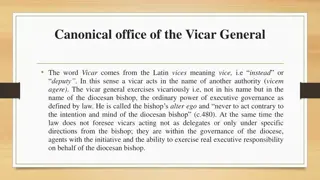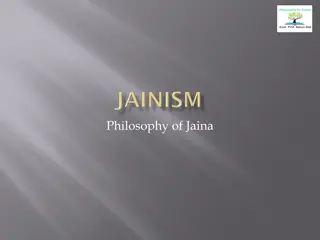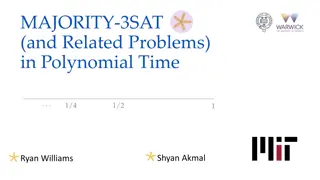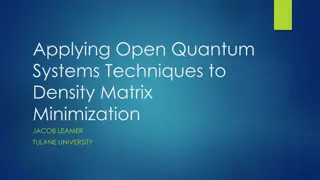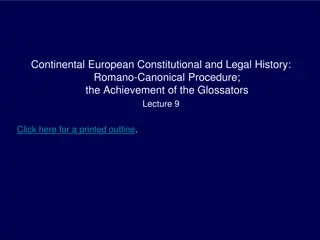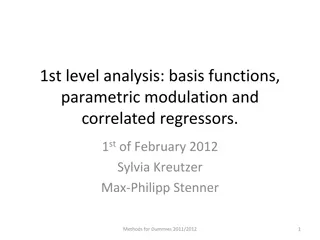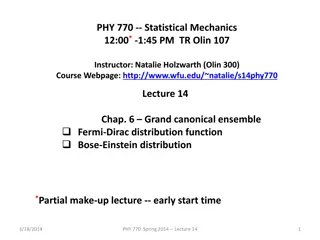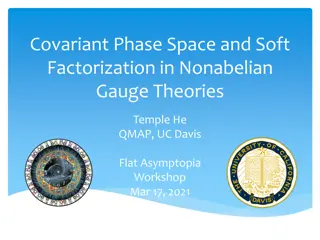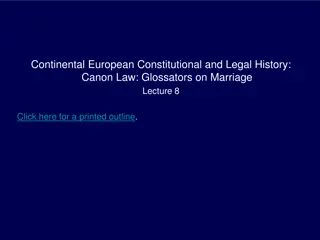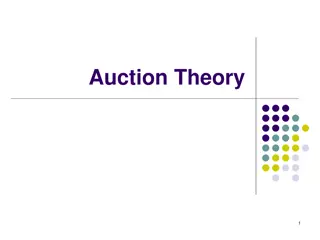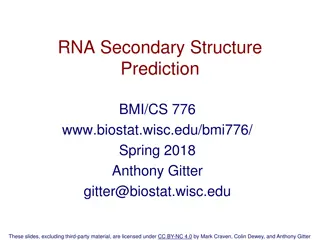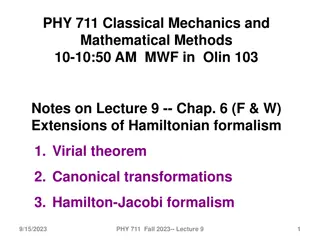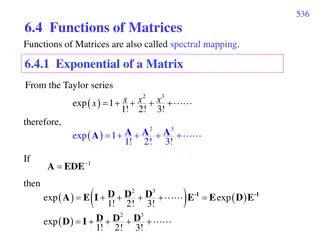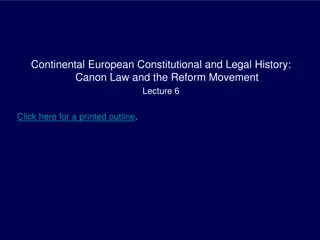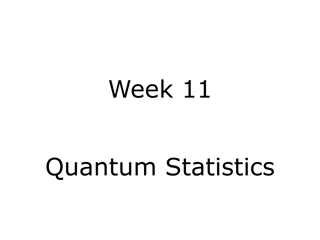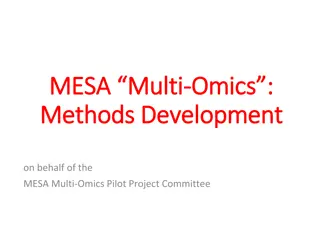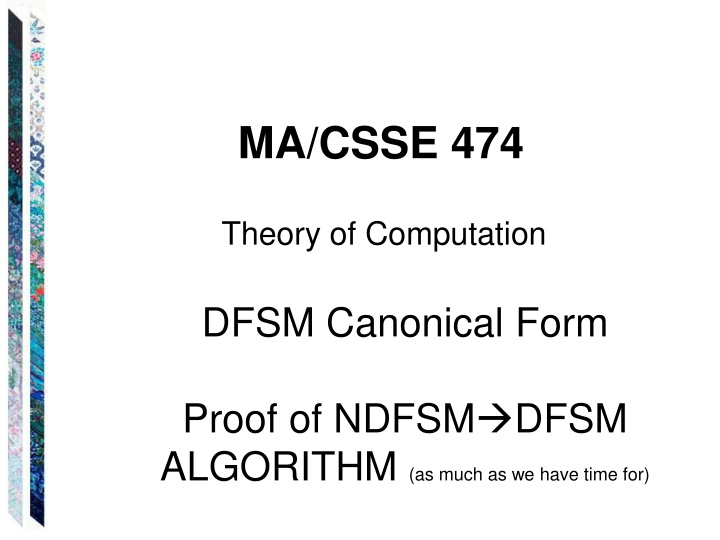
Theory of Computation: DFSM Canonical Form & Minimization Techniques
Explore the Theory of Computation regarding Deterministic Finite State Machines (DFSM), including proofs, algorithms, Myhill-Nerode Theorem, minimization methods, and the Overclustering Approach. Discover the concept of equivalence classes and the uniqueness of minimal accepting machines.
Download Presentation

Please find below an Image/Link to download the presentation.
The content on the website is provided AS IS for your information and personal use only. It may not be sold, licensed, or shared on other websites without obtaining consent from the author. If you encounter any issues during the download, it is possible that the publisher has removed the file from their server.
You are allowed to download the files provided on this website for personal or commercial use, subject to the condition that they are used lawfully. All files are the property of their respective owners.
The content on the website is provided AS IS for your information and personal use only. It may not be sold, licensed, or shared on other websites without obtaining consent from the author.
E N D
Presentation Transcript
MA/CSSE 474 Theory of Computation DFSM Canonical Form Proof of NDFSM DFSM ALGORITHM (as much as we have time for)
Your Questions? Previous class days' material Reading Assignments HW5 problems Tuesday's Exam Anything else
Example (continued) L = { w {a, b}* : no two adjacent characters are the same } Equivalence classes of L: [1] [ ] [2] [a, aba, ababa, [3] [b, ab, bab, abab, ] [4] [aa, abaa, ababb ]
The Myhill-Nerode Theorem Theorem: A language is regular iff the number of equivalence classes of L is finite. Proof: Show the two directions of the implication: L regular classes of L is finite: If L is regular, then the number of equivalence The number of equivalence classes of L is finite L regular: If the cardinality of L is finite, then
So Where Do We Stand? 1. We know that for any regular language L there exists a minimal accepting machine ML. 2. We know that |K| of ML equals the number of equivalence classes of L. 3. We know how to construct ML from L. 4. We know that ML is unique up to the naming of its states. But is this good enough? Consider:
Minimizing an Existing DFSM (Without Knowing L) Two approaches: 1. Begin with M and collapse redundant states, getting rid of one at a time until the resulting machine is minimal. 2. Begin by overclustering the states of M into just two groups, accepting and nonaccepting. Then iteratively split those groups apart until all the distinguishable states have been distinguished.
The Overclustering Approach We need a definition for equivalent , i.e., mergeable states. Define p qiff for every string w *, either w takes M to an accepting state from both q and p or it takes M to a rejecting state from both q and p. Is an equivalence relation?
Construct as the Limit of a Sequence of Approximating Equivalence Relations n (Where n is the length of the input strings that have been considered so far) Consider input strings, starting with , and increasing in length by 1 at each iteration. Start by overclustering the states. Then split them apart as it becomes apparent (with longer and longer strings) that they are not equivalent
Constructing n p 0q iff they behave equivalently when they read . In other words, if they are both accepting or both rejecting states. p 1q iff p 0qand they behave equivalently when they read any string of length 1, i.e., if any single character sends both of them to an accepting state or both of them to a rejecting state. Note that this is equivalent to saying that any single character sends them to states that are 0 to each other. p 2q iff p 1q and they behave equivalently when they read any string of length 2, which they will do if, when they read the first character they land in states that are 1 to each other. By the definition of 1, they will then yield the same outcome when they read the single remaining character. And so forth.
Constructing , Continued More precisely, p,q K and any n 1, q np iff: 1. q n-1p, and 2. a ( (p, a) n-1 (q, a))
An Example = {a, b} Equivalence classes: 0 = 1 = 2 =
MinDFSM MinDFSM(M: DFSM) = 1. classes := {A, K-A}; 2. Repeat until no changes are made 2.1. newclasses := ; 2.2. For each equivalence class e in classes, if e contains more than one state do For each state q in e do For each character c in do Determine which element of classes q If there are any two states p and q that need to be split, split them. Create as many new equivalence classes as are necessary. Insert those classes into newclasses. If there are no states whose behavior differs, no splitting is necessary. Insert e into newclasses. 2.3. classes := newclasses; 3. Return M* = (classes, , , [sM], {[q: the elements of q are in AM]}), where M* is constructed as follows: if M(q, c) = p, then M*([q], c) = [p] goes to if c is read
Summary Given any regular language L, there exists a minimal DFSM M that accepts L. M is unique up to the naming of its states. Given any DFSM M, there exists an algorithm minDFSM that constructs a minimal DFSM that also accepts L(M).
Canonical Forms A canonical form for some set of objects C assigns exactly one representative to each class of equivalent objects in C. Further, each such representative is distinct, so two objects in C share the same representation iff they are equivalent in the sense for which we define the form. In order for a canonical form to be useful, there must be a procedure which, given an object from the set, computes its canonical form.
A Canonical Form for FSMs buildFSMcanonicalform(M: FSM) = 1. M = ndfsmtodfsm(M). 2. M* = minDFSM(M ). 3. Create a unique assignment of names to the states of M*. 4. Return M*. The simple algorithm for unique name assignment is in the textbook; we will illustrate it here by doing an example. Given two FSMs M1 and M2: buildFSMcanonicalform(M1) buildFSMcanonicalform(M2) iff L(M1) = L(M2). =
The Algorithm ndfsmtodfsm ndfsmtodfsm(M: NDFSM) = 1. For each state q in KM do: 1.1 Compute eps(q). 2. s' = eps(s) 3. Compute ': 3.1 active-states = {s'}. 3.2 ' = . 3.3 While there exists some element Q of active-states for which ' has not yet been computed do: For each character c in M do: new-state = . For each state q in Q do: For each state p such that (q, c, p) do: new-state = new-state eps(p). Add the transition (q, c, new-state) to '. If new-state active-states then insert it. 4. K' = active-states. 5. A' = {Q K' : Q A }.
Correctness Proof of ndfsmtodfsm To prove: From any NDFSM M = (K, , , s, A), ndfsmtodfsm constructs a DFSM M'= (K', , ', s', A'), which is equivalent to M. K' P(K) (a.k.a. 2K) s' = eps(s) A' = {Q K : Q A } '(Q, a) = {eps(p): p K and (q, a, p) for some q Q}
Correctness Proof of ndfsmtodfsm From any NDFSM M, ndfsmtodfsm constructs a DFSM M', which is: (1) M' is Deterministic: By the definition in step 3 of ', we are guaranteed that ' is defined for all reachable elements of K' and all possible input characters. Further, step 3 inserts a single value into ' for each state-input pair, so M' is deterministic. (2) M' is Equivalent to M: We constructed ' so that M' mimics an all paths simulation of M. We must now prove that that simulation returns the same result that M would.
A Useful Lemma Lemma: Let w be any string in *, let p and q be any states in K, and let P be any state in K'. Then: (q, w) |-M* (p, ) iff ((eps(q), w) |-M' * (P, ) and p P) . INFORMAL RESTATEMENT OF LEMMA: In other words, if the original NDFSM M starts in state q and, after reading the string w, can land in state p ( along at least one of its paths), then the new DFSM M' must behave as follows: Furthermore, the only-if part implies:
A Useful Lemma Lemma: Let w be any string in *, let p and q be any states in K, and let P be any state in K'. Then: (q, w) |-M* (p, ) iff ((eps(q), w) |-M' * (P, ) and p P) . Recall: NDFSM M = (K, , , s, A), DFSM M'= (K', , ', s', A'), It turns out that we will only need this lemma for the case where q = s, but the more general form is easier to prove by induction. This is common in induction proofs. Proof: We must show that ' has been defined so that the individual steps of M', when taken together, do the right thing for an input string w of any length. Since the definitions describe one step at a time, we will prove the lemma by induction on |w|.
Base Case: |w| = 0, so w = if part: Prove: (eps(q), ) |-M' * (P, ) p P (q, ) |-M*(p, )
Base Case only if part: We need to show: (q, ) |-M* (p, ) [ (eps(q), ) |-M'* (P, ) and p P ]
Induction Step Let w have length k + 1. Then w = zc where z * has length k, and c . Induction assumption. The lemma is true for z. So we show that, assuming that M and M' behave identically for the first k characters, they behave identically for the last character also and thus for the entire string of length k + 1. The Definition of '(Q, a) = {eps(p) : q Q ((q, a, p) )}
What We Need to Prove The relationship between: The computation of the NDFSM M: (q, w) |-M* (p, ) and The computation of the DFSM M': (eps(q), w) |-M'* (P, ) and p P
What We Need to Prove Rewriting w as zc: The computation of the NDFSM M: (q, zc) |-M* (p, ) and The computation of the DFSM M': (eps(q), zc) |-M'* (P, ) and p P
What We Need to Prove Breaking w into two pieces: The computation of the NDFSM M: (q, zc) |-M* (si, c) |-M* (p, ) and The computation of the DFSM M': (eps(q), zc) |-M'* (Q, c) |-M' (P, ) and p P In other words, after processing z, M will be in some set of states S, whose elements we write as si. M' will be in some "set" state that we call Q. Again, well split the proof into two parts: In the M derivation above, the second |-M has a * due to the possibility of epsilon moves. In the M' derivation there is no * because of no epsilon moves in a deterministic machine.
If Part We must prove: (eps(q), zc) |-M'* (Q, c) |-M' (P, ) and p P (q, zc) |-M* (si, c) |-M* (p, )
Only If Part We must prove: (q, zc) |-M* (si, c) |-M* (p, ) (eps(q), zc) |-M'* (Q, c) |-M' (P, ) and p P
Back to the Theorem If w L(M) then: The original machine M, when started in its start state, can consume w and end up in an accepting state. (eps(s), w) |-M'* (Q, ) for some Q containing some state r A. In the statement of the lemma, let q equal s and p = r for some r A. Then M', when started in its start state, eps(s), will consume w and end in a state that contains r. But if M' does that, then it has ended up in one of its accepting states (by the definition of A' in step 5 of the algorithm). So M' accepts w (by the definition of what it means for a machine to accept a string).
Back to the Theorem If w L(M) (i.e. the original NDFSM does not accept w): The original machine M, when started in its start state, will not be able to end up in an accepting state after reading w. If (eps(s), w) |-M'* (Q, ), then Q contains no state r A. This follows directly from the lemma. The two cases, taken together, show that M' accepts exactly the same strings that M accepts.

